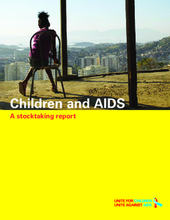Unite for Children, Unite against AIDS was launched in October 2005 with the goal of putting the ‘missing face’ of children at the centre of the global HIV/AIDS agenda. In the year since, the world’s response to protect and support AIDS-affected children remains tragically insufficient. But in important and positive ways, that is beginning to change.
This report takes stock of some of the most important actions and changes for children affected by HIV/AIDS that have taken place in the first year of this campaign. The report finds that children and AIDS had by 2006 become more clearly integrated into national policy frameworks, including national plans of action (NPAs) and poverty reduction strategy papers (PRSPs) in at least 20 countries in sub-Saharan Africa. It finds increasing numbers of children now receiving treatment as a result of improved testing, lower drug prices and simpler formulations. It reports that in several countries, behaviour change has translated into declining HIV prevalence among young people. And the disparity between orphans and non-orphans in access to education has been reduced in several countries.
This report seeks to identify discernible trends through the measurement of new and existing data in the areas of preventing mother-to-child transmission of HIV, providing paediatric treatment, preventing infection among adolescents and young people, and protecting and supporting children affected by HIV/AIDS – the ‘Four Ps’.
Further, this report reviews progress towards support strategies identified as critical elements of a child-focused response. It seeks to illuminate some of the ways in which Unite for Children, Unite against AIDS has shown relevance and promise, as well as some of the ways it has failed to spur the global, regional and country mobilization required to address the problems facing children affected by AIDS. It will also explore how Unite for Children, Unite against AIDS needs to move forward in the next year to achieve its ambitious goals.
©UNICEF

